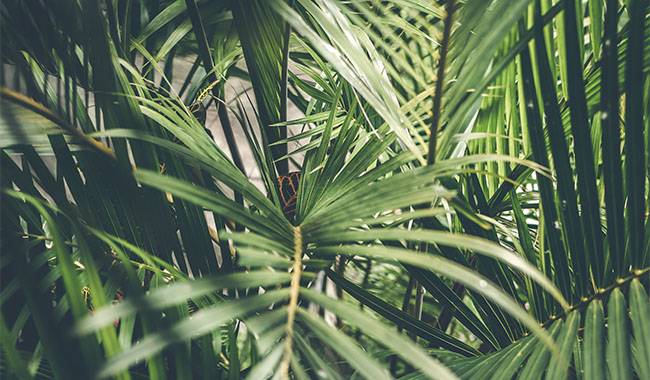
This species is the most widespread endemic palm of the northern peninsula; it is locally common in arroyos and canyon bottoms, and has been observed growing in rock crevices at higher elevations. It is sometimes found with Washingtonia filifera or Washingtonia robusta
Description of Brahea armata
| Scientific | Brahea armata (Synonym: Erythea armata, E. glauca, E. roezlii) |
| Common | Mexican blue fan palm, blue hesper palm |
| Family | Arecaceae |
| Origin | Native to rocky canyons of Baja California and Sonora, Mexico. |
Height: up to 50 feet tall (15 m) or more. It has a stout trunk. Its distinctly bluish leaves are 1-2 meters wide, with meter-long petioles. The leaves are persistent in nature, forming a shag around the trunk; in cultivation they are typically burned or cut off. The inflorescences extend out beyond the crown, reaching 5 meters in length. The flowers themselves are small, appearing in February and March, while the fruits are 18-24 mm in length, brown and with a generally ovoid to globose shape.
B. armata has an attractive appearance, especially when young, and is commonly available at nurseries in the American southwest. It is drought tolerant (although occasional deep irrigation is recommended), can handle both partial shade and full sun, and temperatures down to -10 degrees C. Will take minumum temperatures down to 10°F (-12°C). Germination: erratic, 1 to 12 months.
Several years old seed will grow. Leaf type: Costapalmate, Glaucous blue grey. Stiff, 25-30 leaves per crown, divided in 40 to 60 leaflets. Petiole extends to more than half of the central leafblade., 8-9 feet wide (2.4 to 2.7 m). non-divided, slightly armed with dark thorns, wooly wax cover. Trunk: Gray, smooth with leaf scars, or occasionally, persistant dead leaves, slightly swollen at the base, Up to 18 inches (45 cm).
Flower: Monoecious. Flower stalk coming from between the leaves, from the crown, very long spadix, and flower, (up to 15 feet – 4.5 m). Fruit: brown. 0.8 inch. round edible. Seed: round.
Hardiness zones: Sunset 12-17, 19-24
USDA: 8 (with cold protection), 9-11 (arid and semi arid region best)
Brahea armata features
Elegant single-stem palm tree with trunk-like elephant skin, semi-self-shedding. Its stature is similar to that of a California palm tree (except for the color of the leaves). It is a reserved and elegant palm tree.
The large leaves are carbamate (with a longitudinal rib), are bluish-gray, and partly split into as many as 30 to 50 vanes. The petiole is only lightly armed (dark brown spines) and extends to more than half of the middle leaf. The leaves on mature specimens can spread to 5 to 9 feet in width; rough lines.
The long, curved stem contains a strand of beige flowers, and then the distinctive golden yellow gradually fades into black inedible fruit. The plume of flowers and fruits easily exceeds twice the width of the leaf crown. But the ripe fruit is edible.
Brahea armata uses
Focus on palm trees, residential and commercial plantations, a multi-purpose palm tree, used for texture and color decoration, meso, oasis, and landscape design in arid and semi-arid climates. brahea armata does not grow in humid subtropical or tropical climates, such as Florida. Because it likes drying.
Brahea armata Growth habit
This is a very slow-growing palm tree, especially when it is young, but will eventually reach 30 feet or higher. At 15 years from seed, it will be only about 5 to 8 feet tall.
In early summer, cream-colored flower feathers and golden fruit braids, gray-blue leaves throughout the year, are really good palms! Hardy to 15 degrees Fahrenheit, it can be used in inland and more northern landscapes, entering the USDA Zone 8. More cold-resistant than California palm, even if it is found naturally farther south.
Good soil drainage is required, and sometimes magnesium fertilizer may be needed, in areas where the soil is too alkaline. In the Phoenix area, it grows fastest in former agricultural soils. In desert areas, irrigation is generally infrequent. Water more often in the hot summer. No pruning is required except for removing old or wilted leaves. This palm recovers very slowly after severe peeling, so do not trim the Mexican blue fan palm like Washington’s palm.
Tips for Brahea armata
brahea armata is a great palm genus. Blue Hesper Palm is an alternative to the relatively small and verdant California palm, an excellent palm for Southern California and Arizona landscapes. Please pay attention to this large specimen in downtown Los Angeles! Easy to transplant-transplant larger box or container specimens because they grow slowly.
Note for Brahea armata
Recent biomedical studies have shown that the hydroalcoholic extract of the peel and core of the brahea armata fruit can inhibit the activity of 5-α-reductase type II, which is mainly expressed in the prostate and can The main target of anti-benign prostatic hyperplasia and prostate cancer drugs.



